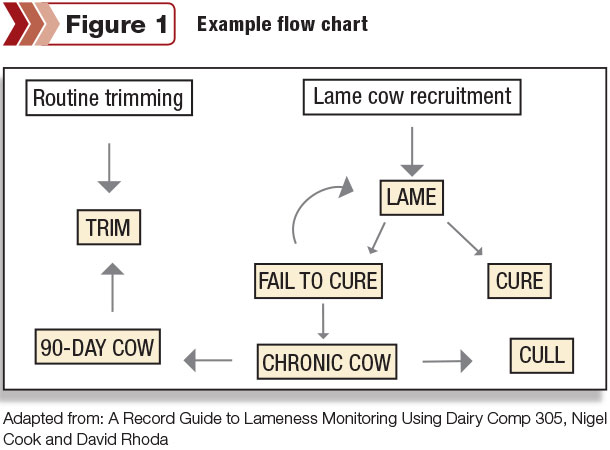The sheer volume of information collected on a dairy farm may seem daunting to track, but proper record-keeping can play a vital role when making decisions.
One area that may not receive as much attention is animal health events, especially hoof health.
How would your current animal health records rate if they were compared to the requirements established by the FDA Code of Federal Regulations 21CFR530.5?
This specific federal government regulation defines the information which shall be included for permanent individual animal health records. According to 21CFR530.5, the following information shall be recorded in a veterinary record:
- Identification of the animal
- Established name of the drug and its active ingredient
- Condition treated
- Species of the treated animal
- Dosage administered
- Duration of the treatment
- Number of animals treated
- Specified withdrawal, withholding or discard time for meat and milk
The regulation does not state that animal identification needs to be an official identification. Official eartag identification exists in two forms: the USDA-approved metal tag and the radio frequency identification.
The USDA-approved metal tag consists of a two-digit, two letter and four-digit sequence; for example, for bovines originating from Wisconsin, the first two-digit number is 35.
The radio frequency identification consists of 15 digits with the first three digits of 840. However, all animal health records must be maintained for a minimum of two years, according to the Code of Federal Regulations.
Recording extra-label drug use
Most animal medication products used for hoof health are used in an extra-label drug use manner. Use of these animal medical products requires veterinary oversight through a valid veterinary-client-patient relationship and a veterinary prescription.
A veterinary-client-patient relationship is an agreement between a veterinarian – known as the veterinarian of record – and the producer/owner. The veterinary-client-patient relationship establishes accountability for medication, overall responsibility for treatment protocols, medication inventories, prescriptions, personnel training and oversight.
The veterinary-client-patient relationship exists for a variety of reasons. It ensures science-based education is utilized for protection of patients and provides consumers the confidence of safe, high-quality milk and meat products.
If an over-the-counter or prescription product is not used according to the labeled directions, but a veterinarian has given written directions through a prescription to use the medication differently, this drug would be classified as an extra-label drug use.
Extra-label drug use occurs when you change any labeled directions: species, age, dose, route, duration or the condition which is being treated, as these changes will result in a different meat and milk withholding. Only through a veterinary prescription is extra-label drug use legal.
Record-keeping options
A variety of animal record-keeping systems exist, ranging from simple notebook paper to smartphone applications and complex computer software platforms. The choice of the system is dependent on the farm’s needs for information access and comfort level for technology.
Regardless of the system, animal health events should be recorded in a timely manner, and they should contain an accurate abbreviated, coded description.
Some common codes for foot health events include “A” for white-line abscess or fissure, “U” for sole ulcer, “T” for toe ulcer and “F” for foot root. That way a farmer can make an informed individual cow management decision, like sell or treat, based on fact rather than emotion.
When farmers have access to consistent health records, they can evaluate the effectiveness of hoof health management protocols and identification of disease patterns.
-
Apps: One tool to help manage digital dermatitis (DD), an infectious condition of the foot caused by bacteria, is the Zinpro DD Check App.
This app was developed by Dörte Döpfer, Tom Bennett and Marlene Tremblay of the food animal production medicine section, school of veterinary medicine, University of Wisconsin – Madison. Users can record individual cow lesion data by using an iPad or iPhone, which can be used cowside in the pen, stanchion barn, chute or parlor.
The DD infection model can assist in predicting the status of the disease, therefore allowing strategies of treatment, control and prevention to decrease the DD incidence rate. A lower incidence rate can lead to more milk production and profitability.
-
Software: Another common tool for record-keeping is computer-based software. A record guide to lameness monitoring was created by Nigel Cook and David Rhoda from the University of Wisconsin – Madison.
The guide demonstrates how to set up a lameness monitoring system in different stages and also includes a flow chart describing different possible lame events on a dairy farm (Figure 1).
Make time to keep records
Time may be a limiting factor for consistent, accurate and informative animal health records. According to Vic Daniels, hoof trimmer and owner of Vic’s Custom Clips, it takes approximately 10 seconds for a hoof trimmer to read a cow’s identification and enter it into a record system. However, it takes approximately four times as long to enter lesions and treatments for an animal with poor foot health versus an animal with minor or moderate lesions.
Time is the main reason hoof trimmers may not keep accurate records beyond what is noted on the final hoof trimming bill. Daniel strongly advocates that keeping proper records can improve hoof health and increase the number of cows trimmed per day because you’re trimming rather than treating in the chute. This can benefit the hoof trimmer and the dairy farm from a financial standpoint.
There are several benefits to having accurate records on a dairy farm. Just remember to keep them accurate, consistent and informative no matter what type of records you are keeping. PD
Eric Ronk is the University of Wisconsin Extension agriculture agent for Calumet County. Sarah Mills-Lloyd, DVM, is the University of Wisconsin Extension agriculture agent for Oconto County, specializing in dairy and livestock.
References omitted but are available upon request. Click here to email an editor.
PHOTO: Entering dairy information into the computer. Staff photo.





